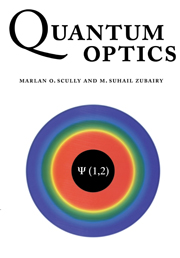Book contents
- Frontmatter
- Contents
- Dedication
- Preface
- 1 Quantum theory of radiation
- 2 Coherent and squeezed states of the radiation field
- 3 Quantum distribution theory and partially coherent radiation
- 4 Field–field and photon–photon interferometry
- 5 Atom–field interaction – semiclassical theory
- 6 Atom–field interaction – quantum theory
- 7 Lasing without inversion and other effects of atomic coherence and interference
- 8 Quantum theory of damping – density operator and wave function approach
- 9 Quantum theory of damping – Heisenberg–Langevin approach
- 10 Resonance fluorescence
- 11 Quantum theory of the laser – density operator approach
- 12 Quantum theory of the laser – Heisenberg–Langevin approach
- 13 Theory of the micromaser
- 14 Correlated emission laser: concept, theory, and analysis
- 15 Phase sensitivity in quantum optical systems: applications
- 16 Squeezing via nonlinear optical processes
- 17 Atom optics
- 18 The EPR paradox, hidden variables, and Bell's theorem
- 19 Quantum nondemolition measurements
- 20 Quantum optical tests of complementarity
- 21 Two-photon interferometry, the quantum measurement problem, and more
- Index
1 - Quantum theory of radiation
Published online by Cambridge University Press: 05 June 2012
- Frontmatter
- Contents
- Dedication
- Preface
- 1 Quantum theory of radiation
- 2 Coherent and squeezed states of the radiation field
- 3 Quantum distribution theory and partially coherent radiation
- 4 Field–field and photon–photon interferometry
- 5 Atom–field interaction – semiclassical theory
- 6 Atom–field interaction – quantum theory
- 7 Lasing without inversion and other effects of atomic coherence and interference
- 8 Quantum theory of damping – density operator and wave function approach
- 9 Quantum theory of damping – Heisenberg–Langevin approach
- 10 Resonance fluorescence
- 11 Quantum theory of the laser – density operator approach
- 12 Quantum theory of the laser – Heisenberg–Langevin approach
- 13 Theory of the micromaser
- 14 Correlated emission laser: concept, theory, and analysis
- 15 Phase sensitivity in quantum optical systems: applications
- 16 Squeezing via nonlinear optical processes
- 17 Atom optics
- 18 The EPR paradox, hidden variables, and Bell's theorem
- 19 Quantum nondemolition measurements
- 20 Quantum optical tests of complementarity
- 21 Two-photon interferometry, the quantum measurement problem, and more
- Index
Summary
Light occupies a special position in our attempts to understand nature both classically and quantum mechanically. We recall that Newton, who made so many fundamental contributions to optics, championed a particle description of light and was not favorably disposed to the wave picture of light. However, the beautiful unification of electricity and magnetism achieved by Maxwell clearly showed that light was properly understood as the wave-like undulations of electric and magnetic fields propagating through space.
The central role of light in marking the frontiers of physics continues on into the twentieth century with the ultraviolet catastrophe associated with black-body radiation on the one hand and the photoelectric effect on the other. Indeed, it was here that the era of quantum mechanics was initiated with Planck's introduction of the quantum of action that was necessary to explain the black-body radiation spectrum. The extension of these ideas led Einstein to explain the photoelectric effect, and to introduce the photon concept.
It was, however, left to Dirac to combine the wave-and particlelike aspects of light so that the radiation field is capable of explaining all interference phenomena and yet shows the excitation of a specific atom located along a wave front absorbing one photon of energy. In this chapter, following Dirac, we associate each mode of the radiation field with a quantized simple harmonic oscillator, this is the essence of the quantum theory of radiation.
- Type
- Chapter
- Information
- Quantum Optics , pp. 1 - 45Publisher: Cambridge University PressPrint publication year: 1997



